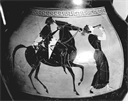Description
The man on horseback is wearing a zeira, a colorfully patterned cloak common in ancient Thrace. The dancing flutist in front of him and the kylix, or wine-cup, in his right hand suggest that he is not riding into battle, but is returning home after a symposion, a gathering of men for the drinking of wine and the discussion of topics, either serious or frivolous, assigned by the host. Scenes from such parties abound on decorated amphorae like this, which were used for storing wine, as well as on kylikes like the one in the rider’s hand, which were used for drinking wine. Greek drinking customs, right down to the mixing of wine with water in proportions specified by the host, typified their general principle of moderation in all things. Plato even offered age-specific advice on drinking, cautioning young men, who tended toward high spirits anyway, but encouraging older men who inclined toward quiet reserve. Part of the rationale for drinking during symposia was to experience the expansive fervor that wine produces. The intellectual goal was to free the mind to explore another side of oneself. Such interior explorations are sometimes epitomized on vases associated with drinking, as it is on this one, by showing the participants in nonconforming clothing.
Greek vases were not glazed, but painted with engobe, a thin slip made from finely sifted clay, which turned black in the complex firing process. The technique used here, of painting the figures and other motifs black and leaving the background the natural red color of the clay, gave way, just around the time this vase was painted, to the opposite procedure, in which potters painted the background black, and reserved the figures in red. This created a more natural appearance, apparently an important goal for Greek artists of the following century.
- J. Hanson
Bibliography
M. C. Ross, Bulletin of the Fogg Art Museum 9.4 (1941), esp. 70.
The Dumbarton Oaks Research Library and Collection of Harvard University, Handbook of the Collection (Washington, D.C., 1946), 90, no. 166, fig. p. 93.
The Dumbarton Oaks Collection, Harvard University (Washington, D.C., 1955), 130, no. 255, fig. p. 134.
J. D. Beazley, Attic Black-Figure Vase-Painters (Oxford, 1956), no. 1, (The Hypobibazon Class).
G. M. A. Richter, Catalogue of Greek and Roman Antiquities in the Dumbarton Oaks Collection (Cambridge, 1956), 49, no. 33, pl. 21.
Handbook of the Byzantine Collection (Washington, D.C., 1967), 87, no. 300.
B. Cohen, "Ethnic Identity in Democratic Athens and the Visual Vocabulary of Male Costume," in Ancient Perceptions of Greek Ethnicity, Center for Hellenic Studies Colloquia 5, ed. I. Malkin (Washington, D.C., Cambridge, Mass., 2001), esp. 247, fig. 9.6.
G. Bühl, ed., Dumbarton Oaks: The Collections (Washington, D.C., 2008), 20, pl. p. 21.
Acquisition History
Collection of E. Zoumpoulakis;
Purchased from Joseph Brummer (dealer), by Mildred and Robert Woods Bliss, December 1937 [Bummer object inventory card number X797].
Collection of Mildred and Robert Woods Bliss, Washington, D.C., December 1937-November 1940.
Dumbarton Oaks Research Library and Collection, Byzantine Collection, Washington, D.C.






